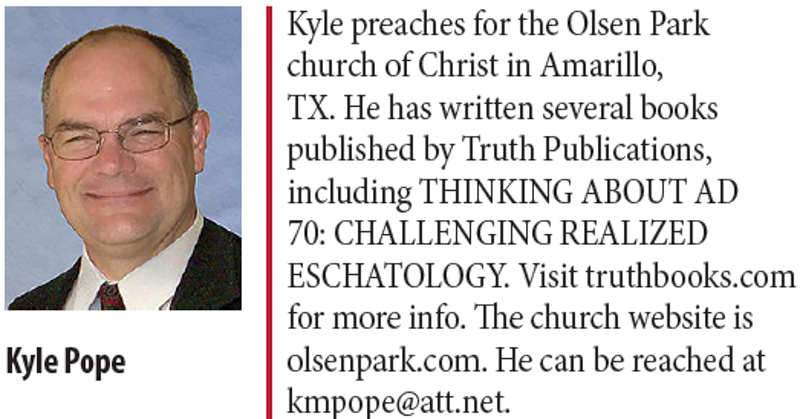by Kyle Pope
Synopsis: The religious world is divided, but is this division pleasing to God? Is there a way believers in Jesus Christ can be united, upholding only the teachings and practices that characterize the church Jesus built?
When properly balanced, form, freedom, and function are concepts that make for a productive Christian life.
During a recent lunch-time conversation with Jake Locklear, one of our deacons at Adoue Street, we discussed the executive coaching that he received several years ago. The instructor asked him to read “The Inner Game of Tennis,” written by Tim Gallwey, which has been a continual bestseller since it was first published in 1974. Valuable insights apply, not only to sports, but also to leadership and life.
Success in sports involves proper techniques and mastering the mind. Muscle memory and mental discipline are both important.
Learning the game of baseball requires proper training and mastering proven techniques. Yet, it is equally important to internalize those guidelines, then get in the groove, and go with the flow. This applies to a young athlete’s mastery of baseball, and my passion for running, as well as practicing the Christian faith.
The Bible is our standard: it contains a pattern to which our lives must be conformed.
But thanks be to God that though you were slaves of sin, you became obedient from the heart to that form of teaching to which you were committed, and having been freed from sin, you became slaves of righteousness (Rom. 6:17-18).
The Greek word tupos, translated “form,” refers to “the mark (of a blow), an impression, stamp (made by a die)” (Thomas, 5179b).
Providing a more detailed definition, Arndt says tupos refers to “(1) a mark made as the result of a blow or pressure; (2) the embodiment of characteristics or function of a model; (3) an object formed to resemble some entity; (4) a kind, class, or thing that suggests a model or pattern; (5) the content of a document; (6) an archetype serving as a model” (BDAG, 1019-1020). In summary, it referred to a design, example, form, image, model, mold, pattern, or type.
“Blueprints” provide the dimensions of a structure and details regarding its construction. When Moses built the tabernacle, God said, “See that you make all things according to the pattern (tupos) which was shown you on the mountain” (Heb. 8:5; cf. Exod. 25:40). In the gospel dispensation, Christ provides a pattern for personal discipleship, our roles and responsibilities in the home, and a “blueprint” for the work, worship, and organization of the church. Like Timothy, let us “retain the standard of sound words which you have heard from me (i.e., the inspired apostle Paul), in the faith and love which are in Christ Jesus” (2 Tim. 1:13).
When the scribes and chief priests asked, “Is it lawful for us to pay taxes to Caesar, or not?” Jesus said, “Show Me a denarius. Whose likeness and inscription does it have?” They said, “Caesar’s.” And He said to them, “Then render to Caesar the things that are Caesar’s, and to God the things that are God’s” (Luke 20:22-25).
In Roman times, ruling emperors minted coins in their own honor. The emperor’s image appeared on one side of the coin and symbols of his power were on the other. Ancient coins were produced by using a mint, press, or mold. Regardless of the specific process employed, the emperor’s image was transferred from the coin die to the coin as it was hammered or pressed, or by pouring molten metal into a mold. As Roman coins bore the image of the reigning Caesar, we must bear the image of our Sovereign, the Lord Jesus Christ.
For those whom He foreknew, He also predestined to become conformed to the image of His Son, so that He would be the firstborn among many brethren (Rom. 8:29).
The first man is from the earth, earthy; the second man is from heaven. As is the earthy, so also are those who are earthy; and as is the heavenly, so also are those who are heavenly. Just as we have borne the image of the earthy, we will also bear the image of the heavenly (1 Cor. 15:47-49).
But we all, with unveiled face, beholding as in a mirror the glory of the Lord, are being transformed into the same image from glory to glory, just as from the Lord, the Spirit (2 Cor. 3:18).
As the inspired apostle Paul served as a model of proper behavior (2 Thess. 3:6-12, esp. vv. 8-9), we should be positive role models: “You became an example to all the believers in Macedonia and in Achaia” (1 Thess. 1:2-7, esp. vv. 6-7).
While we are free in Christ, this does not grant unlimited license. We are not free to follow a different standard (Gal. 5:1). We are not free to transgress, or serve another master, or to act selfishly—rather, we are free to serve the Lord and our brethren (Gal. 5:13-15; 1 Pet. 2:15-16).
We are free of the curse of sin, free from the burdens of the law of Moses, free from the restrictive (or indulgent) precepts of men. Within the parameters of the gospel message, we are free to love, live, and labor for the cause of Christ.
It was for freedom that Christ set us free; therefore keep standing firm and do not be subject again to a yoke of slavery (Gal. 5:1).
For you were called to freedom, brethren; only do not turn your freedom into an opportunity for the flesh, but through love serve one another. For the whole Law is fulfilled in one word, in the statement, “YOU SHALL LOVE YOUR NEIGHBOR AS YOURSELF.” But if you bite and devour one another, take care that you are not consumed by one another (Gal. 5:13-15).
For such is the will of God that by doing right you may silence the ignorance of foolish men. Act as free men, and do not use your freedom as a covering for evil, but use it as bondslaves of God (1 Pet. 2:15-16).
It is not enough to stress the importance of having proper form, or in celebrating the liberation that comes through proper freedom. Ultimately, we must put these concepts into practice. We must be doers of the word, not hearers only, blinded by self-deception. Ezra was an outstanding leader in the eyes of men and God because he followed a path of learning/studying, practicing, and doing: “Ezra had set his heart to study the law of the LORD and to practice it, and to teach His statutes and ordinances in Israel” (Ezra 7:8-10). As a result, when serious issues needed to be addressed, the people stood with Ezra, submitting to his leadership, being resolved to do whatever was necessary to rectify the situation: “Arise! For this matter is your responsibility, but we will be with you; be courageous and act” (Ezra 10:1-8).
Conclusion
Our hope of salvation depends upon our willingness to conform our lives to the gospel pattern, and to be doers of the word, not unproductive hearers. (Jas. 1:21-25).
Arndt, William, et al. A Greek-English Lexicon of the New Testament and Other Early Christian Literature (BDAG). Chicago: University of Chicago Press, 2000.
Thomas, Robert L. New American Standard Hebrew-Aramaic and Greek Dictionaries: Updated Edition. Anaheim: Foundation Publications, Inc., 1998.


